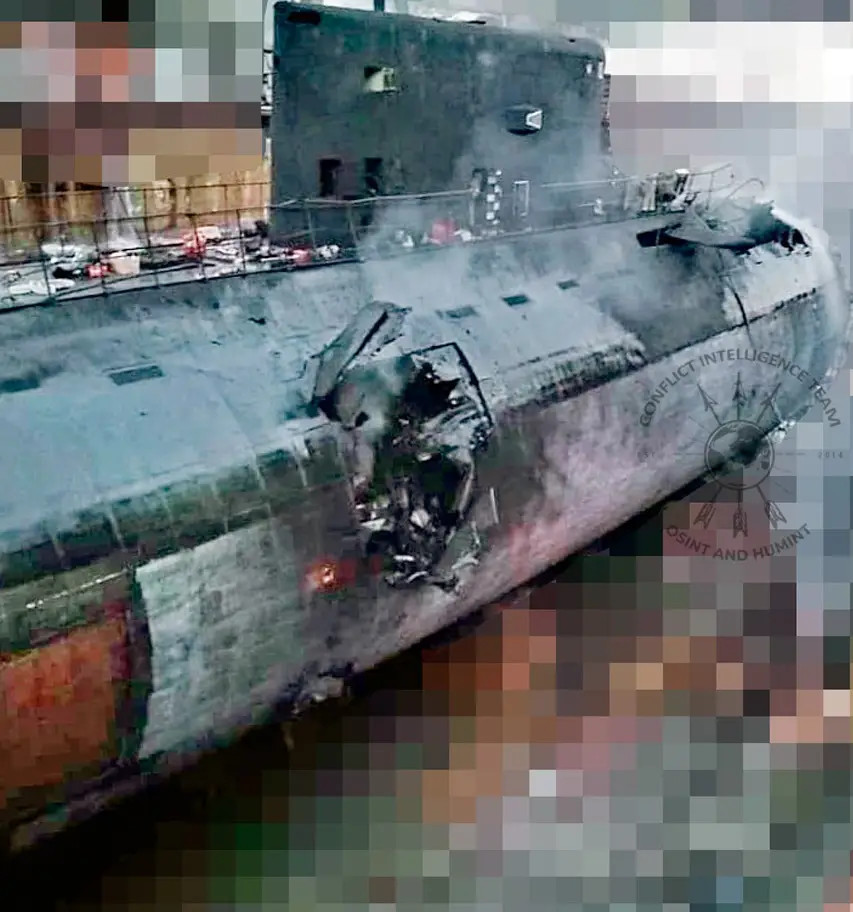Satellite imagery shows that Russian forces have painted a silhouette of a submarine and built an actual structure mimicking a conning tower on a pier at an important naval base on the Black Sea. Broadly similar silhouettes of Tu-95 Bear bombers and other aircraft have appeared at Russian air bases in the past, a trend The War Zone was first to report on. These decoys look intended to help disrupt localized drone attacks and throw off Ukrainian weapons that use some form of autonomous image-matching guidance.
The U.K. Ministry of Defense released a satellite image calling attention to the submarine decoy at the Russian Navy base in Novorossiysk earlier today in a routine intelligence update on the conflict in Ukraine. Russian Kilo class diesel-electric attack submarines are regularly seen docked at this pier, including in the satellite image British authorities have now put out.
Novorossiysk is located on the Black Sea in Russia’s Krasnodar Krai region, which lies just opposite the occupied Crimean Peninsula. Ukrainian forces have targeted Russian military bases, oil refineries, and other sites in Krasnodar Krai in the past. Russia’s military makes heavy use of bases in the region to support its war effort in Ukraine, including as launch points for missile and drone strikes.

“Russian military doctrine places high emphasis on the use of camouflage and deception techniques (often known as maskirovka) to enhance the survivability of Russian forces, as well as conceal their operational intent,” according to the U.K. Ministry of Defense. “Russian forces have highly likely been making efforts to increase and improve their employment of maskirovka techniques to mitigate the heavy losses sustained over the past two years in both the Black Sea Fleet and Aerospace Forces.”
“Silhouettes of vessels have also been painted on the side of quays, probably to confuse Ukrainian uncrewed aerial vehicle operators,” the daily British intelligence update adds. It is not immediately clear if similar naval decoy silhouettes have been observed elsewhere.
This also follows a visit by Russian Defense Minister Sergei Shoigu to the Russian Navy’s Black Sea Fleet headquarters in Crimea on Sunday. While there, Shoigu called for more defenses and better general preparedness against Ukrainian uncrewed surface vessels, which have been wreaking havoc on Russian ships in the Black Eea, as well as uncrewed aerial systems.
However, The War Zone has reviewed additional satellite imagery from Planet Labs that shows the decoy at the Russian Navy’s base in Novorossiysk has been there since at least the end of February. The additional images also make clear that the faux conning tower is a three-dimensional structure and not just painted on the pier.
The U.K. Ministry of Defense’s initial assessment that the Novorossiysk submarine decoy is intended “probably to confuse Ukrainian uncrewed aerial vehicle operators” may also just be one part of the reason for setting up such a decoy.
The types of drones that Ukraine is known to have acquired to date to execute longer-distance strikes on targets in places like Krasnodar Krai do not have any kind of operator-in-the-loop capability and are instead launched at a static set of target coordinates.
Ukraine does send out sabotage teams to conduct much closer-range attacks inside Russia, including using so-called first-person view (FPV) drones and other types with improvised warheads. It is unclear how likely a decoy silhouette on a pier would be to confuse a drone operator hunting for a submarine in port in any context. It could still have some value for deceiving enemies, especially in the heat of the moment and at night.
As The War Zone has noted in the past regarding the aircraft silhouettes at Russian air bases, it seems more likely that the goal is to confuse weapons with guidance packages that utilize autonomous image-matching to find their target.

The Storm Shadow and SCALP-EG air-launched cruise missiles that the United Kingdom and France, respectively, have supplied to Ukraine use an imaging infrared sensor in the terminal phase of flight. The land-attack variant of Ukraine’s domestically developed Neptune ground-launched cruise missile reportedly also uses imaging infrared guidance in the terminal stage of an attack.
The War Zone has also questioned how effective a two-dimensional decoy silhouette might really be at confusing an imaging infrared sensor. The addition of the fake conning tower structure to the decoy in Novorossiysk gives it a useful extra layer of fidelity.
The threat of Ukrainian strikes, especially ones involving cruise missiles, to Russian ships in port is very real. Ukrainian forces significantly damaged, if not destroyed one of the Russian Navy’s Kilo class diesel-electric attack submarines and one of its Ropucha class landing ships in a combined Storm Shadow/SCALP-EG and USV attack on the port of Sevastopol in Crimea in September 2023. Two months later, Russia’s Project 22800 Karakurt class corvette Askold was at least severely damaged in another cruise missile strike as it sat in the Crimean port of Kerch. In December 2023, a Ropucha class landing ship docked in Feodosia, another port city in Crimea, exploded in a ball of fire as a result of a Ukrainian cruise missile strike, which also caused significant damage to the surrounding area.

None of this is to say that Ukraine’s arsenal of aerial drones, including a growing number of types capable of carrying out longer-range kamikaze attacks, does not also pose a real danger to Russian forces and facilities. Ukrainian forces have recently stepped up drone attacks on oil infrastructure across Russia in particular. Uncrewed aerial systems can present threats to naval targets at sea, as well as in port.
Ukraine’s use of cruise missiles, as well as aerial and naval drones, has already prompted Russian forces to implement a wide array of extra force protection measures at various bases, especially in Crimea. The submarine silhouette and mock conning tower on the pier in Novorossiysk are now part of that defensive mix.
Contact the author: joe@twz.com
